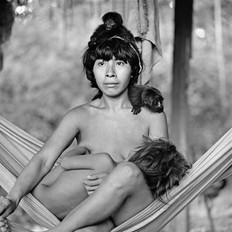
Exposição, Conversa Aberta
Art from the indigenous peoples of Maranhão gets exhibition at the CCVM
26 September 2023 to 17:30
Baskets, masks, necklaces, bracelets, cuias, spears… the art of indigenous peoples is renowned for its plurality of forms, colors and functions. Different graphics distinguish peoples; jenipapa and annatto, raw materials for body dyeing and artifacts, are extracted from nature; trunks become hunting and musical instruments; small beads put together weave designs that adorn and enchant.
All this diversity will be on display starting September 26th, with the exhibition Maranhão: Indigenous Land, at the Vale Maranhão Cultural Center. For the first time, the indigenous peoples who live in the state will be presented through their material cultures, worldviews, territories, and languages. Rituals, myths and oral heritages related to the production on display will be discussed, as well as aspects of the daily life of the indigenous peoples Awa Guajá, Canela Rankokamekra, Canela Apanyekra, Gaviao Kykatejê, Gaviao Pykopjê, Ka’apor, Guajajara Tenentehar, Tupinambá, Krikati, Tembé, Krepun Katejê, Akroá Gamella, Kreniê, Tremembé, Anapuru Muypurá and Warao.
A large part of the exhibition is made up of the CCVM’s collection of indigenous material production, gathered during years of work and research and dialogue with the indigenous peoples of Maranhão. “From an early age, we understood the importance of putting together a collection that could constitute the exhibition we are presenting now. Indigenous material culture is very rich and transcends in meaning, proposing to look at the world differently, to rethink our production agencies and to experience everyday life, to better understand the value of territory and the preservation of life. The purpose of the exhibition is to bathe the visitor with the beauty of indigenous aesthetic propositions, to make us better understand what it means to be indigenous, giving depth to the resistance that peoples have maintained for over 500 years”, explains Gabriel Gutierrez, director of the Vale Maranhão Cultural Center, who signed the conception of the exhibition.
To provide the public with this immersion, the expography of Maranhão: Indigenous Land brings together musical instruments, hunting instruments, pieces used in mourning rituals and festivities, hammocks, basketwork, and a wing dedicated to indigenous clothing, with 15 representations of garments used at different times in everyday life in villages and produced with fabrics, beads and straws; necklaces, bracelets, belts, shin guards, bracelets and headboards made of beads and used as ornaments for ornaments also make up the space rituals, everyday ornaments or marketed.
The exhibition also includes the collection of the Natural History and Archaeology Research Center of Maranhão/ CPHNAMA; photographs by Christian Knepper and the Carlos Estevão Photoethnographic Collection of the State Museum of Pernambuco – MEPE; and a projection of the Ethno-Historical Map of Brazil and Adjoining Regions by ethnologist Curt Nimuendajú.
Indigenous culture is one of the strongest symbols of the struggle of the original peoples to preserve their history, and it crosses Brazilian time and territory. Promoting an exhibition on this topic in the Northeast, funded by the Rouanet Law, reaffirms the Federal Government’s commitment to this resistance agenda. May they increasingly occupy our spaces of critical thinking, so that we never have a country again without the presence and active participation of those who represent our origins, reinforces Henilton Menezes, Secretary of Creative Economy and Cultural Promotion at the Ministry of Culture.
Indigenous audiovisual production from Maranhão stands out
Part of the exhibition presents each of the peoples through texts written by representatives of the ethnic groups or articulators of contacts. To illustrate what visitors will read, clothing, photographs and short films produced by the CCVM are added to the articles, such as Elas – the Krikati Women, WYTY: Os Cantos de Resistência Gavião Pykopjê and Os Warao de Upaon-Açu.
Five more documentaries from three Maranhão peoples – Ka’apor, Awa Guajá and Guajajara – will be screened at the exhibition. The films were made by Guardiões da Memória formed by the Museu da Pessoa with sponsorship from the Vale Cultural Institute. The works are the result of the Maranhão Indigenous Lives project, which trained young people from their respective peoples in the language of audiovisual and carried out actions to preserve and disseminate life stories from the community.
Debate about female strength in the indigenous struggle
The program will also include the conversation circle The importance of female leaders in the indigenous struggle, with the presence of Edilena Krikati, Irene Gavião, Cíntia Guajajara, Rosilene Tembé Ka’apor and mediated by Raquel Tremembé.
The conversation will take place at 17:30 before the opening of the exhibition, which is scheduled for 19:00. All programming is free and open to the public.
Maranhão: Indigenous Land is running until February 17, 2024. The Vale Maranhão Cultural Center is located at Rua Direita, 149, in the Historic Center of São Luís, and is open to visitors from Tuesday to Saturday, from 10 a.m. to 7 p.m.